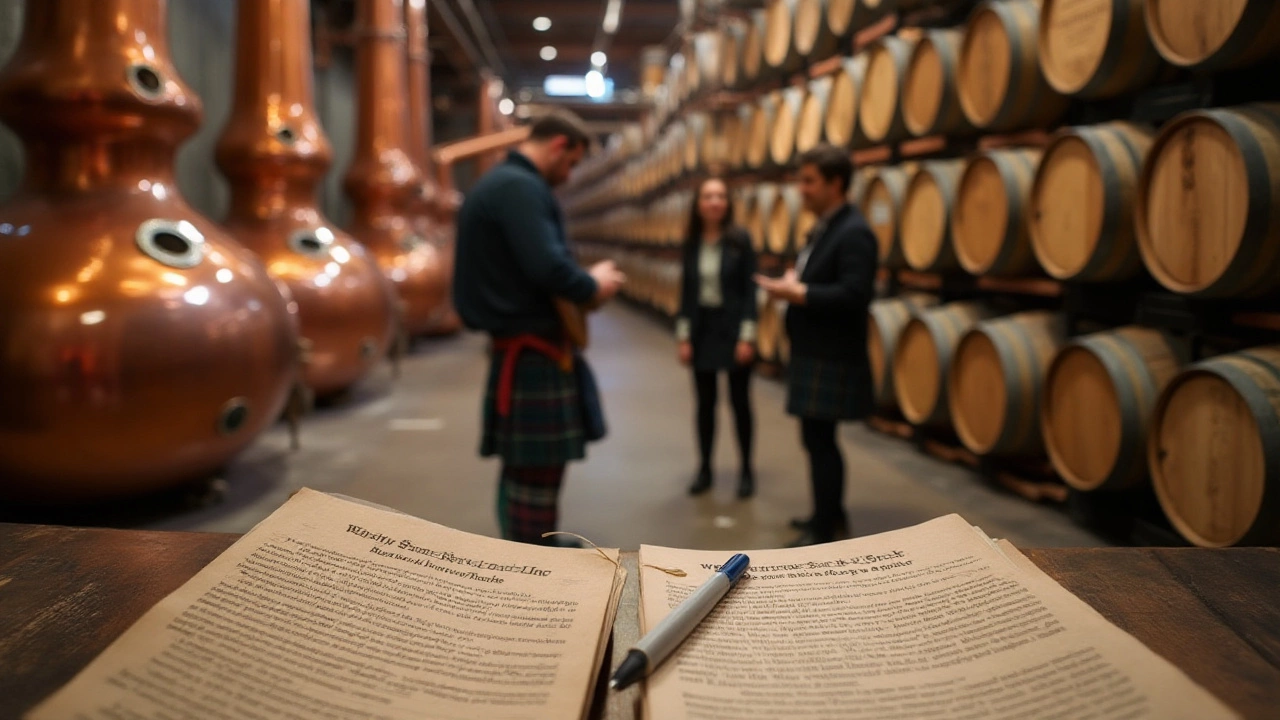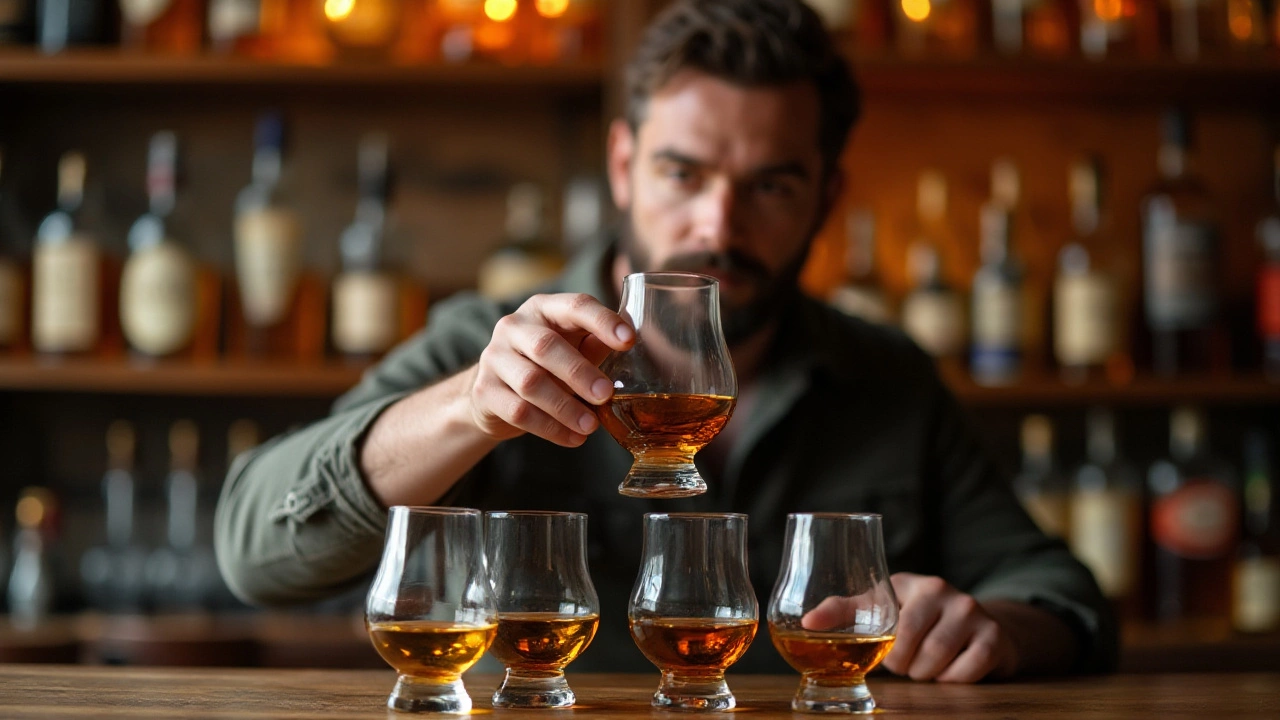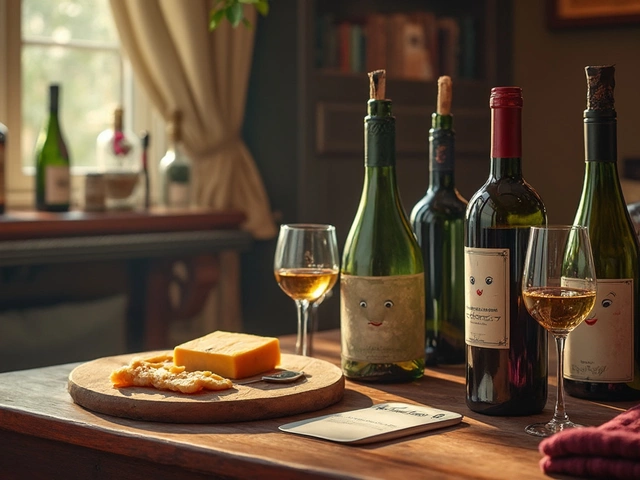Embarking on the journey of whisky tasting is akin to unlocking a treasure chest of flavor and history. Each bottle tells a story, and each tasting reveals new nuances and characteristics. To truly savor whisky, one must dive deep into its complex world, taking note not only of taste but also the aroma, color, and body.
Choosing the right glassware can make a significant difference in your tasting experience. The shape of the glass affects the aroma's delivery to your senses, much like a conductor leads an orchestra. To understand whisky's charm, you'll need to hone in on its aroma, unlocking scents that range from floral and fruity to spicy and rich.
With each sip, you'll begin to identify varied flavor profiles, which can include sweet, salty, bitter, or smoky notes. Examining the color and clarity further enhances your appreciation, offering clues about age, origin, and processing.
Lastly, a few tips and tricks can elevate your tasting, turning it into an unforgettable experience. So, grab your favorite dram and let's dive into the rich and rewarding realm of whisky appreciation.
- Selecting the Right Glass
- Understanding Whisky Aromas
- Identifying Flavor Profiles
- The Importance of Color and Clarity
- Tips for Enhancing Your Tasting Experience
Selecting the Right Glass
When it comes to whisky tasting, choosing the right glass is as critical as the whisky itself. The design of the glass can dramatically shape the way scents and flavors are perceived, transforming a simple sip into an immersive sensory experience. The wide world of whisky offers many different glass styles, each intending to enhance the tasting ritual in its unique way. The key is finding one that most elegantly delivers the olfactory and taste profiles to your senses.
The most traditional choice is the Glencairn glass, coveted for its balance between elegance and utility. Its tulip shape is designed to concentrate complex aromas towards your nose, helping you catch even the most delicate scents. Many professionals use this glass, as it was crafted with input from some of the greatest minds in the whisky industry. Another option is the snifter, similar in shape to the Glencairn but typically larger, allowing for swirling – a technique often used to unleash a whisky's aromatic components.
Consider the copita glass, favored in tastings for decades, which offers a narrow rim that directs the whisky's bouquet with pinpoint accuracy. This style owes its roots to the sherry industry but has been heartily adopted by whisky enthusiasts for the precise sensory perspective it offers. If you're enjoying whisky in a more social setting, the tumbler or "Old Fashioned" glass might suit. It's perfect for sipping whisky over ice or with a mixer, although it shouldn’t be your first choice for a tasting session, as it's not optimized for concentrating aromas.
"The Glencairn glass is the whisky glass of all whisky glasses, allowing the contents to express their fullest potential." - Whisky Advocate
Remember, the glass is not just a vessel for holding liquid; it’s a tool designed to enhance your appreciation of whisky's subtle notes. Selecting the appropriate glass can make the tasting experience richer and more fulfilling. Try experimenting by pouring the same whisky into different glasses and observe how your perception changes. This exercise can reveal surprising facets of your favorite dram and deepen your appreciation for the meticulous craftsmanship behind each bottle.
To summarize, selecting the right glass is not trivial but foundational to the art of whisky tasting. Whether you're exploring a peaty Scotch or a smooth Bourbon, the right glass can unlock flavors and aromas that might otherwise remain hidden. Spectacle meets science here, with the right glass opening a portal into the diverse, flavorful world of whisky.
Understanding Whisky Aromas
Savoring the fragrance of whisky is as essential as tasting it. The aroma is the prelude to each sip, offering a tantalizing glimpse into the depth within the bottle. When it comes to whisky tasting, your nose will be your greatest ally, guiding you through the layers of scent that define a whisky's character. Begin by gently swirling your glass, allowing the liquid to oxygenate and release its fragrant compounds into the air. Bringing the glass to your nose, take a moment to enjoy the olfactory bouquet.
The myriad of whisky aromas can transport you to lush orchards, dense forests, or even coastal shores. You might detect notes such as vanilla, fruit, or peat, depending on the whisky's origin and maturation process. Distilleries across the globe employ unique methods, influencing the end product in surprising ways. For instance, sherry casks impart rich, fruity notes, while bourbon barrels might enhance flavors of honey and caramel. Despite the complexity, identifying these aromas is a skill honed through practice and patience.
Many enthusiasts find similarities between identifying flavor profiles in whisky and exploring a fragrant spice rack in your kitchen. Each scent dances across your senses, from the spice rack's warming cinnamon to the gentle hint of fresh cut grass on a summer day. These aromatic cues act as markers, guiding you toward a deeper appreciation of the distiller's art.
"The nose is the compass that guides us to the heart of the whisky," notes Jim McEwan, a renowned master distiller, whose insights into the sensory experience echo the passion and precision found in this art.
To deepen your understanding, consider keeping an aroma journal, noting the specific scents you encounter and how they relate to the whisky's source. You might be surprised at how your palate grows more adept over time, appreciating subtleties that once eluded you. Scientists have even backed this, explaining that the human nose can distinguish more than a trillion different odors. This incredible capacity turns every whisky tasting session into a personal sensory adventure.
To help you start identifying key aromas, here's a basic categorization that many find useful:
- Fruity: Often reminiscent of fresh apples, pears, or berries, these notes are usually derived from the fermentation process.
- Spicy: A reflection of the casks used, these aromas may include cinnamon, pepper, or nutmeg.
- Smoky: Indicative of peated whisky, these bring to mind bonfires and charred wood.
- Earthy: Think of wet leaves, mushrooms, or soil, adding a deep, rooty character.
As you delve deeper, remember that everyone's journey with whisky and their olfactory senses is unique. The joy lies in the adventure of discovering what each dram has to offer. Whether you're a novice or seasoned tasters, embracing the aromatic journey will enrich your whisky appreciation and bridge a deeper connection with this timeless spirit.

Identifying Flavor Profiles
Diving into the world of whisky flavors is akin to exploring an artist's palette — a vibrant spectrum that transforms each glass into an exquisite liquid tapestry. The journey of identifying these profiles begins with understanding the basic elements of taste: sweet, sour, salty, bitter, and umami. Whisky is particularly adept at exhibiting these tastes due to its complex production process, which includes everything from the type of grain used to the kind of barrel it matures in.
When you take a sip of whisky, pay attention to the initial taste that greets your palate. Is it bold and full-bodied, or light and subtle? Many whiskies open with sweet notes, often reminiscent of caramel, vanilla, or even honey. These flavors are usually a result of the malted barley and the caramelization process during distillation. Yet, as the liquid moves across your tongue, other flavors typically start to emerge. You might notice a zing of citrus or a hint of berries, echoing the fruits used during fermentation.
As the whisky reveals more of its character, you may discern spicier elements like pepper or ginger, often brought out by the interaction with charred oak barrels. Some whiskies can even surprise you with a smoky touch — a signature of peated whiskies, mostly from regions like Islay in Scotland, where the barley is dried using peat smoke. This smoky flavor can be assertive or subtle, depending on the time spent exposed to the smoke.
Understanding flavor profiles also entails recognizing the role of underlying earthy and nutty notes, which may lend an aroma reminiscent of roasted nuts or even tobacco. Such complexities often lead to debates among connoisseurs, each sip turning into a topic for passionate analysis. "The best whisky is the one you like to drink," writes renowned whisky critic Michael Jackson, illustrating the subjective nature of flavor profiles.
If you're looking to improve your ability to identify these profiles, consider a structured tasting session. Start by sampling different whiskies side by side, allowing you to compare and contrast their unique flavor compositions. Keep a journal to note down the aromas and tastes you experience, thereby creating your own reference guide. This method not only enhances your palate but also deepens your appreciation and enjoyment of whisky.
Lastly, remember the role of temperature and environment. Whisky is best enjoyed in an ambient setting, ideally between 15-18°C (59-64°F). Warmer temperatures can slightly alter the taste, making certain flavors more pronounced. Next time you indulge in a tasting, take a moment to acknowledge the artistry in your glass — a blend crafted through tradition, nature, and innovation, waiting to be unraveled with every note.
The Importance of Color and Clarity
The hue and luminosity of a whisky pour more than just aesthetic charm; they unfold a saga of the liquid's journey through time and nature. Observing the color of whisky can provide early hints about its age, the type of casks it has matured in, and the climate of its origin. Typically, a darker whiskey has spent more time in the cask, often absorbing deeper tones from the charred interiors of oak barrels. For instance, whiskies from sherry casks tend to exhibit a rich amber or mahogany hue. However, keep in mind that certain distilleries might use caramel coloring to ensure consistency, which does not impact flavor but alters the visual expectations.
The clarity of the liquid reveals its filtration process. Non-chill-filtered whiskies often appear cloudier at lower temperatures, a sign of retained oils and compounds that enrich flavor. This cloudiness, known as 'louching,' should not be misinterpreted as inferiority. On the contrary, it assures the drinker that nothing has been stripped away, ensuring a robust and full-bodied flavor profile. A clear whisky, filtered of its cloudy esters, might be lighter in body but not necessarily less flavorful.
"The color and clarity of whisky tell stories of maturation that the nose and palate can confirm," says renowned whisky writer and critic Dave Broom.This visual inspection sets the stage for what follows when you lift the glass to your nose.
For a better appreciation of color and clarity, it's advised to use a well-lit environment and a white backdrop. This can be as simple as holding the glass against a white napkin or a sheet of paper. Such methods help delineate the fine details of the hue and transparency. However, be cautious not to judge solely based on color; remember, whisky tasting involves a symphony of senses. An eye-catching golden dram might be equally enthralling in taste, while a paler version could surprise with its complexity. Histories hidden within the cask are locked in the wood-char, offering a tantalizing glimpse into what awaits. These observations enhance your whisky tasting experience, adding another dimension to your appreciation.

Tips for Enhancing Your Tasting Experience
Diving into the world of whisky tasting can feel quite daunting at times, especially with the vast array of brands and flavors available. However, enhancing your tasting experience is less about having an encyclopedic knowledge of whisky and more about refining your senses and setting the right atmosphere. A little preparation goes a long way in transforming a simple sip into a memorable event. Firstly, consider the environment where you choose to do your tasting. A quiet, well-lit room free of any overpowering odors is ideal. The aroma of the room itself can influence your perception of the whisky flavors, so it's best to avoid areas adorned with strong candles or freshly cooked food. This allows your nose to pick up on the subtle aromas that each whisky offers, providing a richer tasting experience.
Temperature plays a crucial role when it comes to tasting whisky. Many enthusiasts agree that room temperature tends to be perfect for unlocking the drink's true potential. Chilling your whisky can sometimes mute the intricate notes that a warmer nip can highlight. You could conduct a small experiment yourself: try tasting the same whisky cold and then at room temperature to see the difference in flavor profiles. This gives you a deeper appreciation for how different serving styles can affect your tasting pleasure. If you also enjoy your whisky with a drop of water, use mineral or spring water, as they won't interfere with the flavors like tap water might.
One noteworthy method is the use of your sense of smell. Developing this ability allows you to delve further into the whisky's character. Spend a few moments inhaling the aroma from the glass before taking a sip. This is called 'nosing' and it can reveal layers of complexity you might miss otherwise. Being patient and allowing your senses to absorb the details can turn tasting into a full-bodied experience. It’s an art in itself, practiced by many seasoned enthusiasts to thoroughly appreciate their favored whisky.
The Perfect Pour
How you pour your whisky is another area that can impact your tasting experience. Unlike wine, where swirling is common practice, whisky is often served still, allowing its flavors to evolve naturally. Consider starting with a small pour to allow your senses to acclimate to its aromas gently. Utilizing a whisky tasting glass is essential as well. Specifically designed to channel aromas, a tulip-shaped glass helps concentrate the nose and open the flavors as you swirl and savor your drink. If you like, once you’ve enjoyed the essence, pour yourself a touch more to let your palate truly relish the offering. For those interested in statistics, it might surprise you that whisky enthusiasts often consume less than 30ml in their initial tasting.
“The first taste and aroma are the most impactful; savor them well, for the first impression will guide the rest of your tasting journey.” - Unknown Whisky Enthusiast
Engaging in whisky tasting is a personal journey, each experience unique and valuable. By honing your skills and investing in these small practices, you smoothen the path towards a lifelong appreciation of this distinguished spirit. Each whisky bottle holds wonders of discovery, waiting to be uncovered by a patient taster like you.


